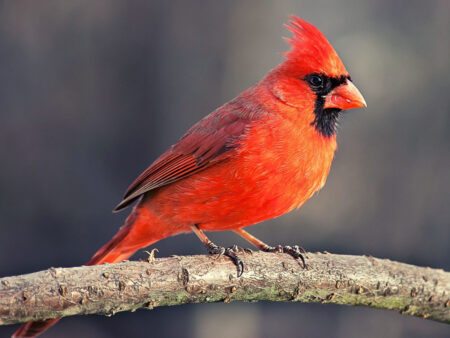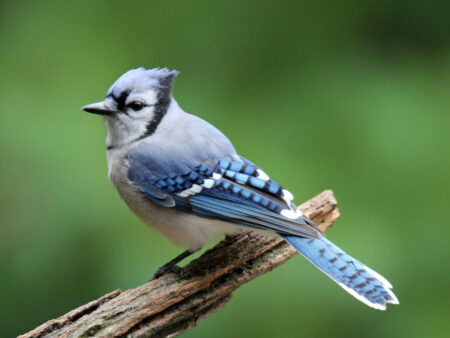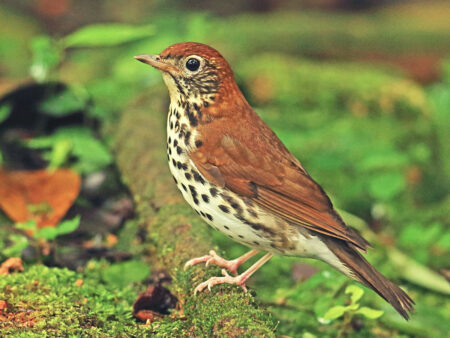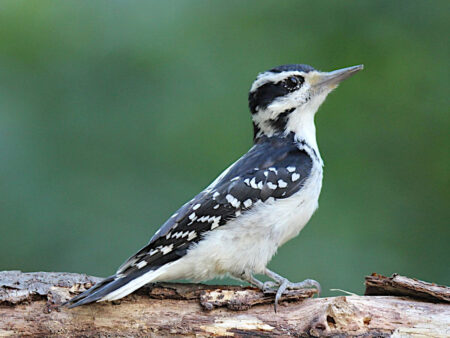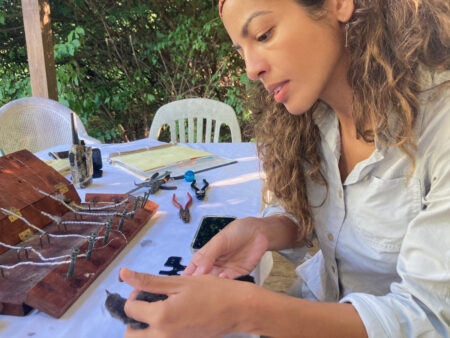
Dayamiris Candelario and her husband Omar traveled from their home island of Puerto Rico to the Willistown Conservation Trust in Pennsylvania for a one-month bird banding internship. As someone new to bird banding it was a steep but rewarding learning curve for Dayamiris. Find out more about her experiences in her blog post below.
“In my hand I held the most remarkable of all living things, a creature of astounding abilities that eludes our understanding, of extraordinary, even bizarre senses, of stamina and endurance far surpassing anything else in the animal world. Yet my captive measured a mere five inches in length and weighed less than half of an ounce, about the weight of a fifty-cent piece. I held that truly awesome enigma, a bird.” (A. C. Fisher Jr.)
My work as an environmental educator at Centro Ambiental Santa Ana, a nature center located in an urban forest in Puerto Rico, involves many activities in bird education. As a member of staff for more than twelve years, I have presented many Endemic and Migratory Birds Festivals and birdwatching workshops for urban residents of the island.
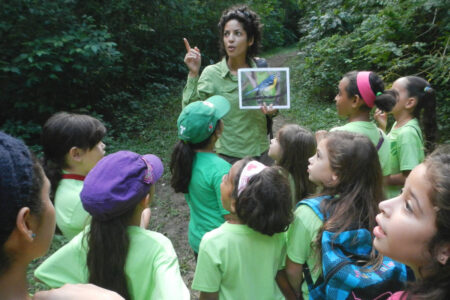
It is here, while preparing for these activities, that my interest in birds peaked. I was often in awe at how these tiny and fragile beings could face so many perils throughout their lives. My daily tasks as an interpretive guide emphasize birds as a key to get my audiences hooked in our Puerto Rican nature. But before the experience that I’m about to narrate, a question always lingered in my mind: “How many secrets do birds hold to overcome their life’s obstacles and still live amazing lives?”
A beautiful setting for bird banding
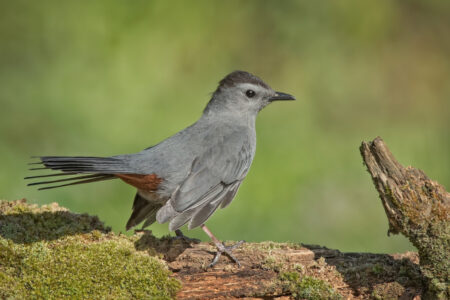
It was a serendipitous invitation that brought me closer to getting answers to my questions about birds. I was invited to release a live Gray Catbird (Dumetella carolinensis) on September 1st of 2022, just after arriving at the Rushton Woods Preserve Bird Banding Station in beautiful Pennsylvania, a natural protected area managed by the Willistown Conservation Trust (WCT).
I was beginning my one-month bird banding training internship with my husband, Omar, hosted by the Willistown Conservation Trust (WCT), in collaboration with BirdsCaribbean, the Powdermill Avian Research Center of the Carnegie Museum of Natural History, and the Northeast Motus Collaboration.
We stayed at the beautiful historic house located next to the Rushton Farm, part of the Preserve. We felt the chilly autumnal breeze in the grasslands, bushes, and meadows. I let the sweet scent of the goldenrod flowers fill my lungs, while listening to the soft rocking of tree branches as the wind commanded their movement. Whenever we walked towards the bird banding station at dawn, we heard the lively chirping and tweeting of the birds. We wanted to learn as much as we could. After participating in the bird banding training activities, which started very early in the morning until almost midday, we would work remotely in our respective jobs. And in the evenings, we would devour all the literature that the Bird Band Station uses for their activities.
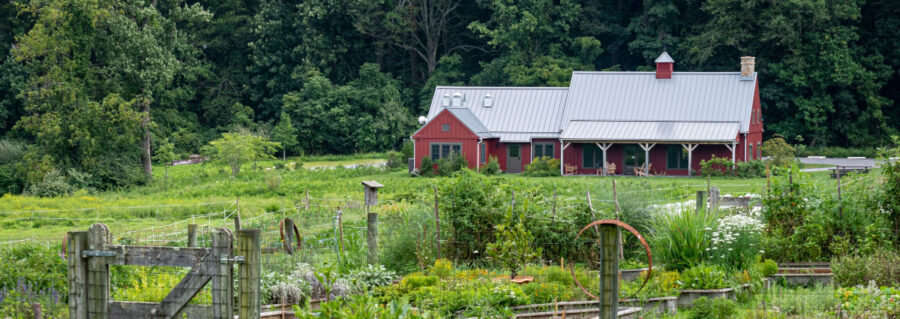
From a beloved pet bird to a wild bird
I still remember what I felt when Blake from WCT put the bird in my hand to let me release it after it was banded. I have held a live bird before: my dear Chuqui, a Cockatiel (Nymphicus hollandicus) that taught me that her dearest person EVER was my husband. He died at fifteen years of age in the hands of her beloved. I learned about Chuqui’s juvenile and preformative plumage; how to correctly sex her (we thought she was a male until she started laying eggs!); her molt once per year (and the mess of feathers that would follow); and how to not expose her to artificial light to avoid her laying eggs. I remember feeling her tiny bones and observing carefully the differences of her body feathers from the wings and tail.
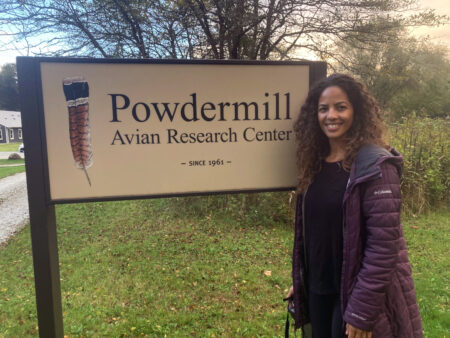
Our experience at WCT was different, however, because I was touching for the first time a bird that faces the daily challenges of being wild and free—the “Green Fire,” as described by Aldo Leopold in the film, “A Land Ethic Of Our Time.” I remember feeling the vibration of the Gray Catbird’s body, the warmth of its belly, and how it grabbed my fingers tightly with its toes. That was my first encounter with the daily work of education, research and conservation of this bird banding station, which has been operating for 14 years, as part of the WCT’s Bird Conservation Program.
How (or how not) to extract a bird
In the following weeks, Lisa Kiziuk, Director of the Bird Conservation Program, and her staff introduced me to the station’s inner workings as well. I learned the proper timing and setting up of mists nets and their location; how to extract birds from nets ;the different bird banders’ grips to ensure birds are handled safely ;the most common species banded; species that are selected for radio tags to detect migration patterns; and the different sizes of bands used. Measurements were taken to determine population health, habitat preferences, and to detect changes that could signal a threat. Some of these measurements are: the wing chord, weight, fat deposits, molt, and aging, which was the most challenging for a novice like me.
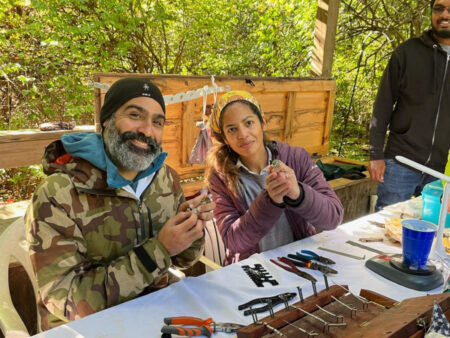
I remember how frustrated I was the first time I tried to extract birds because I was fearful that I might hurt them. I later realized that bird extraction is a puzzle with a time limit—you need to figure out in a short time how to free wings, head, legs, and feet from the thin and entangled fibers of the nets. In particular, I had some delightful moments of laughter from my encounters with the House Wren (Troglodytes aedon). After several failed attempts at the net to extract them, they escaped and looked at me triumphantly from a nearby branch! In the end I did extract one, but it still got away when I was about to band it! Thanks to the patient training, supervision, and guidance of Lisa and her staff, my final bird banding tally was 41 birds from at least eleven different species – most en route to their southern journey, and some not commonly seen wintering in Puerto Rico.
The meow of the Gray Catbird and the blue of the Blue Jay…
One of the most common species at the station, the Gray Catbird, was very memorable because it is not as common in Puerto Rico. Therefore, whenever this bird is spotted in the island, a generalized buzz from birders would follow in order to watch and hopefully listen to this bird’s peculiar “meowing” while wintering in the Caribbean. I proudly banded 16 of them (comprising 40% of my first bird banding training batch) – which created envy among my local fellow birders!
The Northern Cardinal also left a memory and some bite marks in my fingers too!! I was told this species was a “biter” and I can proudly declare that I survived its powerful beak. Also, I was in awe when I had the pleasure of banding a Blue Jay (Cyanocitta cristata) – a beautiful and HUGE bird that stayed calmly in my grip while I banded it. I did observe its exceptionally long feathers (resembling silky hair) as I blew on its head, breast and belly looking for molt and fat deposits. I have never seen a blue so magnificently blue!!
…And a very special bird
But I have a special place in my “bird bander’s” heart for the Wood Thrush (Hylocichla mustelina). I will never forget how I often peeked at the bird bag to take hold of it. I always found a beautiful large eye looking at me. Next, I would feel the warmth of its round belly, while its bright brown and streaked plumage seemed as if it was painted on the bird. Some other species that I banded included: Swainson’s Thrush (Catahrus ustulatus), Ovenbird (Seiurus aurocapilla), Gray-cheeked Thrush (Catharus minimus), American Redstart (Setophaga ruticilla), Hairy Woodpecker (Dryobates villosus), and Downy Woodpecker (Dryobates pubescens).
Motus installations and wild apples: A great learning opportunity in Vermont
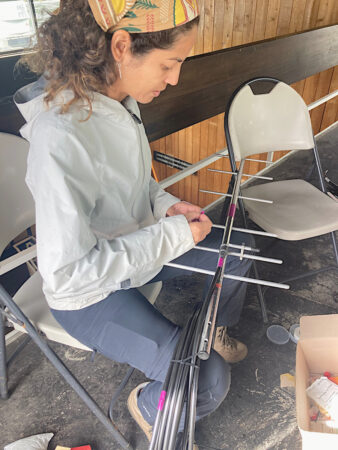
We also learned from WTC about efforts through the Northeast Motus Collaboration to promote bird conservation through research, especially by installing antennas to track the movements of birds in the northeast of the U.S. We accompanied the antenna installation team in their task of installing three antennas in the beautiful state of Vermont: one at Bennington College, another at Wolcott Research Station at the University of Vermont, and the last one in Smugglers’ Notch Resort in Jeffersonville. Assisting them in installing these antennas with their metal tubes, cables and bolts served as a reminder of the amount of background work involved in installing all this infrastructure, all to aid ornithologists and researchers as they seek to understand bird movements.
On a funny note, I also discovered that you could easily find wild apples to eat in many places in Vermont!
Thanks to WTC, we had the once-in-a-lifetime opportunity to stay for a few days at the Powdermill Nature Reserve to learn about the operation of its Avian Research Center, part of the Carnegie Museum of Natural History of Pittsburgh (CMNH). We observed a major bird banding operation at one of the oldest bird banding stations in the U.S., 60 years in operation. We were amazed at the number of mist nests they could operate with a small staff. We also learned about the research being carried out onsite to determine the best glass window materials to prevent bird collisions. We got to know many of the staff from the station and some other personnel from the Museum, who invited us to visit their avian specimen collection. We took a good look, and asked a million questions.
Kindness and support for a “newbie” bird bander
For me, a newcomer in bird banding, I have to say that I was very fortunate to be able to answer my existential question about birds because of all the kind, patient, and warm people that offered us their best skills, knowledge, guidance, food, coats, places to stay, opportunities to meet new people, jokes and laughter, making us feel at home and ready to learn while being away from Puerto Rico. From the WTC there was Lisa, Fred, Allison, Blake, Aaron, Shelly, Kirsten, Todd, Phyllis, and Holly; and at CNMNH Cheyenne, Cullen, Annie, Lucas, Loren, Mallory, Rose, and Serina.
Birds inspired me, and brought us together
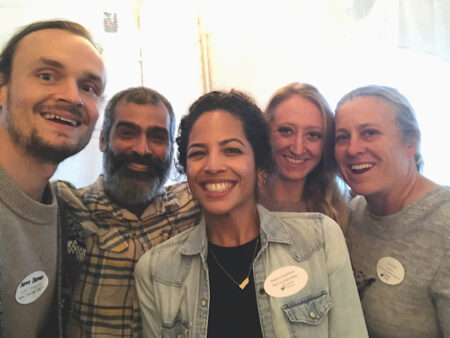
As I write this article, I am in the middle of my second opportunity to train in bird banding – this time in my home island, learning with resident species and Holly Garrod, Project Manager of BirdsCaribbean’s Bird Banding Program, which is working hard to build capacity for banding in the region through workshops, providing bird bands, and banding internship opportunities, like this one.
I thank all of the people who inspired me to want to become better at this new skill. Fingers crossed that in the near future I will become a certified bander. This will help me amplify my capabilities and skills as an Environmental Scientist and Educator, furthering the conservation of birds as a gateway to the conservation of all Nature.
The birds’ wings, molts, beaks, songs and amazing journeys did much more than just existing. The birds succeeded in uniting people from different backgrounds, languages and cultures, who continue to work, in awe of their amazing superpowers.
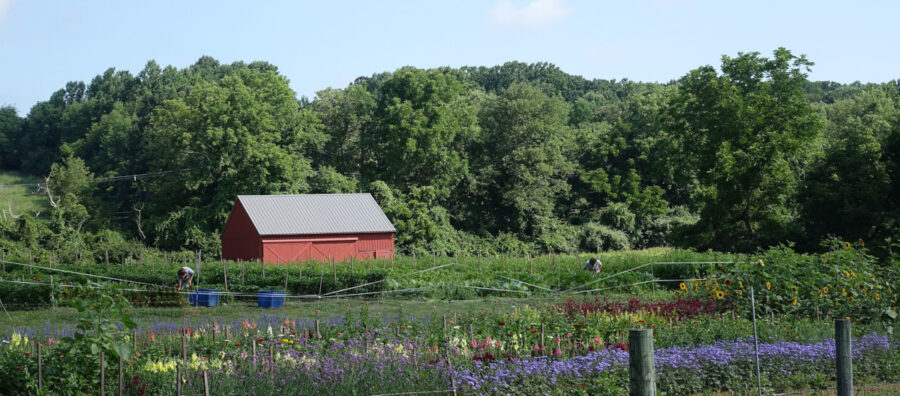
Dayamiris Candelario is an Environmental Manager that works currently as an Environmental Educator for Centro Ambiental Santa Ana, a nature center located in an urban forest in the island of Puerto Rico; and as a Coordinator for the Blue Flag Program for Organización Pro Ambiente Sustentable. Daymi is also a Certified Interpretive Guide from the National Association for Interpretation (NAI), and uses these skills to provide meaningful experiences to Puerto Rican children about their local nature. Her experience involves environmental education initiatives, many focusing on endemic and migratory birds, in outdoor informal settings, community projects, and research on air pollution and karst ecosystems. In her free time, she enjoys birdwatching, drawing and painting nature, traveling, writing, and hiking in natural areas.

